Why do we fall ill? Summary Class 9 Science
Introduction
- ‘Health’ is a state of being well enough to function well physically, mentally and socially.
- Disease: Any disturbance in the structure or function of any organ or part of body.
- The various causes of diseases are pathogens (virus, bacteria), lack of nutritious diet/balanced diet and lack of public health services.
- Acute diseases occur suddenly and lasts for a short duration while chronic diseases develop slowly and lasts for long period of time.
- The diseases/infections can be prevented by life style (exercise, proper sleep, enough relaxation) modification, taking balanced diet, good personal health and hygiene and also maintaining a clean and healthy surrounding.
- Treatment involves killing of the microbes/pathogens.
Health
- Health is a state of physical, mental and social well-being.
The conditions necessary for good health are:
- Good physical and social environment.
- Good economic conditions.
Good physical and social environment includes clean surroundings, good sanitation, proper garbage disposal and clean drinking water.
Good economic conditions includes job opportunities for earning to have nutritious food and to lead a healthy life.
Personal and Community Issues Both Matter for Health
Community Health
- All those activities which people do both individually and in groups for the development of their society, constitute the community health.
- Personal and community health are supplementary to each other.
- We protect ourselves by keeping our body clean.
- For this, we also require a good and healthy environment in our surroundings.
- We can have this only by the means of community health and development.
- So, both personal and community health are inter-related.
Differences between Being Healthy and Disease-free
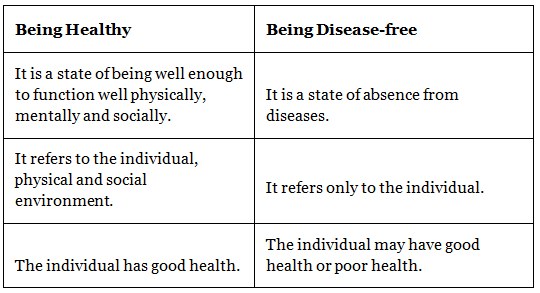
Disease and Its Causes
What does disease look like?
- When a person is affected by a disease either the functioning or the appearance of one or more systems of the body will change for the worse.
- These changes give rise to symptoms and signs of disease.
- On the basis of the symptoms the physicians look for the signs of a particular disease and conduct tests to confirm the disease.
Types of Diseases
- Acute Diseases: Acute diseases which last for only very short period of time and affect body suddenly and quickly. Example: Cold, cough, typhoid etc.
- (Chronic Diseases: The diseases which last for a long time, even as much as a life time, are called chronic diseases. Example: Diabetes, tuberculosis, elephantiasis etc.
Causes of Diseases
Diseases are caused by:
- Pathogens like virus, bacteria, fungi, protozoans or worms.
- Poor health and under nourishment.
- Hereditary and genetic disorder.
- Lack of proper treatment of immunization.
- Environmental pollution (air, water etc.)
Infectious and Non-infectious Diseases
- Infectious Diseases: The diseases which spread due to infection by micro-organisms are called infectious diseases.
- It is communicated from diseased person to healthy person, caused by some biological agents/pathogens like viruses, bacteria, fungi, protozoans, fungi worms.
- Non-infectious Diseases: The disease which does not spread by contact between infected and healthy person through air and water, is called non-infectious disease.
Example: Arthritis, heart disease.
Pictures of Different Micro-organisms
SARS Viruses
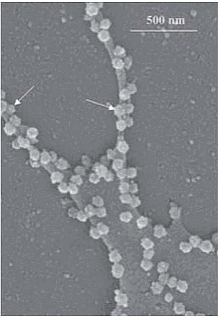
- SARS viruses are coming out of the surface of an infected cell (see the arrows for example).
- 500 nanometer = 0.5 micrometer = 0.001 millimeter.
Trypanosoma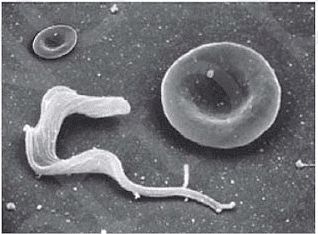
- Trypanosoma is a protozoan organism.
- It causes sleeping sickness.
- The saucer-shaped substance lying next tothe protozoa, is a red blood cell.
Staphylococcus bacteria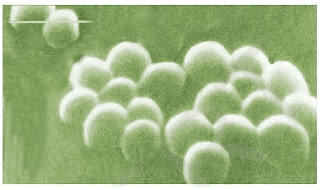
- The Staphylococcus bacteria causes acne.
- The scale is indicated at the line at the top left of the picture. It is 5 micrometers long.
Adult roundworm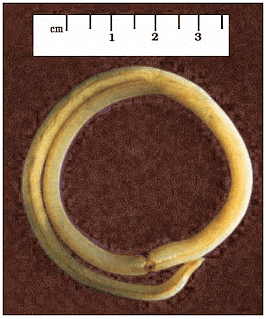
- Adult roundworm is found in the small intestine.
- Its technical name is Ascaris Lumbricoides.
- The ruler next to it shows 4 centimeter to give an idea of the scale.
Leishmania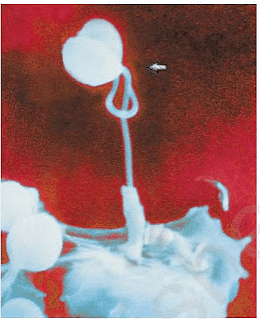
- Leishmania, the protozoan organism causes kala-azar.
- The organisms are oval-shaped, and each has one long whip-like structure.
- The immune cell is about ten micrometres in diameter.
Micro-organisms
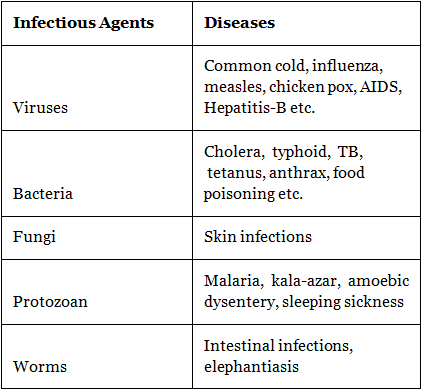 Antibiotics
Antibiotics
- Antibiotics blocks biochemical pathways important for bacteria. Hence, they are effective against them. Example: Penicillin, tetracycline.
- Many bacteria make a cell wall to protect themselves, the antibiotics (Penicillin) blocks the bacterial process that builds cell wall.
- Antibiotics works only against the bacteria and not against the viruses.

Means of Spread of Infectious Diseases
Infectious diseases spread from an infected person to a healthy person through air, water, food, vectors, physical contact and sexual contact.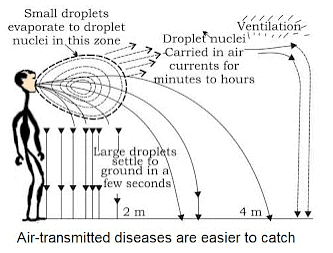
- Through air: By sneezing and coughing, the microbes spread into air and enter into the body of a healthy person, like common cold, tuberculosis, pneumonia etc.
- Through water: The microbes enter into our body by drinking/eating polluted and contaminated water/food, like cholera, amoebic dysentery etc.
- Vectors: Some organisms like female anopheles mosquito also work as a vector of disease, like malaria, dengue, yellow fever etc.
- Through sexual contact: Syphilus, AIDS spread by sexual contact with infected person. AIDS virus can also spread through blood transfusion and from the mother to her child during pregnancy and through breast feeding.
AIDS (Acquired Immuno Deficiency Syndrome)
Causes of AIDS
- AIDS is caused by a retro-virus called HIV (Human Immuno Deficiency Virus).
Method of transmission of AIDS
- The transmission of AIDS from an infected to a healthy person takes place :
- through sexual contact
- blood transfusion
- use of infected needle or blade etc.
- This may also get transmitted from infected mother to her foetus.
Prevention of AIDS
- Avoid transfusion of infected blood. This can be done by testing whether the blood is HIV negative or not.
- Always use disposable needle and syringe.
- Avoid sexual contact with unknown person.
- Avoid the same razor used in the salons.
ORGAN – Specific and Tissue-specific Manifestations
Disease causing microbes enter the body by different means and goes to different organs and tissues.
- Microbes which enter through the nose are likely to go to the lungs. (Bacteria which cause tuberculosis of lungs).
- Microbes which enter through the mouth are likely to stay in the gut (bacteria which causes typhoid) or liver (bacteria which causes jaundice).
- Virus which causes AIDS enter the body through sexual organs during sexual contact and spread through the lymph to all parts of the body and damages the immune system.
- Virus which causes Japanese encephalitis (brain fever) enters the body through mosquito bite and goes and infects the brain.
Principles of Treatment
The treatment of infectious diseases consists of two steps. They are to reduce the effects of the disease (symptoms) and to kill the microbes which caused disease.
- To reduce the effects of the disease: This can be done by taking medicines to bring down the effects of the disease like fever, pain or loose motions etc. and by taking bed rest to conserve our energy.
- To kill the microbes: This can be done by taking suitable antibiotics and drugs which kills the microbes and the disease is cured.
Principles of Prevention
There are two ways of prevention of infectious diseases. They are general ways and specific ways.
- General ways of prevention: Public hygiene is most important for prevention of infectious diseases. Proper and sufficient food for everyone will make people healthy to resist the infection.
- Air borne diseases can be prevented by living in conditions that are not crowded. Water borne diseases can be prevented by providing safe drinking water.
- Vector borne diseases can be prevented by providing clean environment.
- Specific ways of prevention: There are disease specific measures which are used to fight them. It is done by Immunisation.
- This is the process of introducing a weakened pathogen inside the body of the host to fool his/her immune system to produce antibodies against that particular disease.
- Not only does our immune system fight the disease (feeble pathogen), but also keeps a memory of the incident by keeping those antibodies in blood.
- Thus, next time even if the disease will strike the host’s body with full vigor, the body will be able to protect itself with the help of these antibodies.
- This is also the basic law followed by vaccination programmes done for infants.
List of Few Diseases
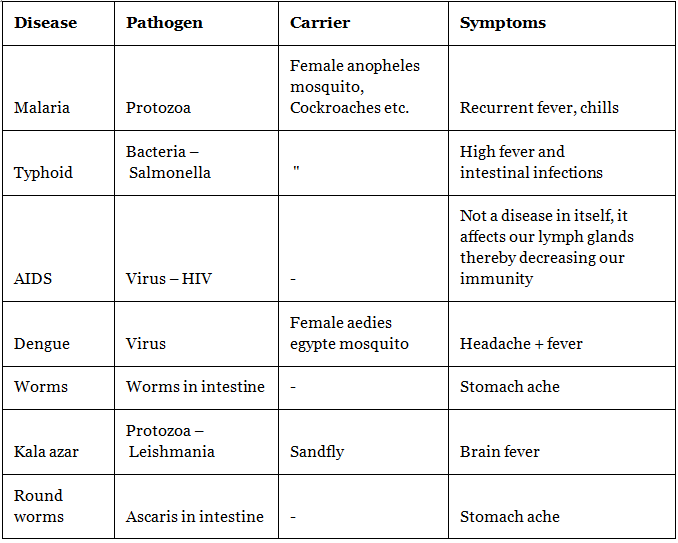

|
493 videos|387 docs
|
















